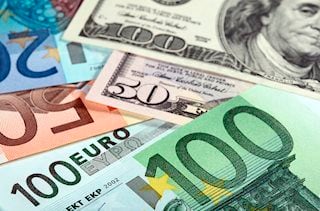EUR/USD Forecast: Failure at 1.10, intensifying Sino-American friction, may fuel a fall
|
- EUR/USD has been retreating amid intensifying Sino-American relations.
- Speculation about the next central bank moves stands out.
- Wednesday's four-hour chart is showing some weakness after failing to top 1.10.
Are markets finally coming to grips with the consequences of the world's largest economies tussling about everything? While stock markets continue their gradual ascent, the safe-haven US dollar is gaining some ground.
The main point of contention is Hong Kong as pro-democracy activists plan another day on the streets in protest against China's new security law – which may become even tighter. American lawmakers are moving forward to certify that the city-state is not autonomous and to slap sanctions. HK is a major Asian financial hub.
The US and China are also at loggerheads around technology. Oppo – China's second mobile phone maker after Huawei – is accelerating its plans to develop its own chips rather than rely on American products. Both Washington and Beijing have pledged to hold up the trade deal – soothing investors. However, this silver lining may not hold for long.
Markets seem somewhat more optimistic about coronavirus. Falling numbers in both America and Europe, gradual steps to reopen economies, and additional vaccine efforts are keeping the mood upbeat. Merck, a major pharmaceutical firm, poured some cold water on hopes for an early vaccine, but various efforts are underway, including from Inovio, Moderna, and Novavax.
Central banks are now in the spotlight. Speculation is mounting ahead of next week's European Central Bank decision. The Frankfurt-based institution is operating in the shadow of the German constitutional court's ruling that the bank's bond-buying scheme is partly illegal. However, Isabel Schnabel, a German member of the Governing Council, dismissed concerns.
The ECB may opt to expand its special Pandemic Emergency Purchase Program (PEPP) to as much as €1 trillion from the current €750 billion. Another topic is relaxing its capital key limits, enabling it to focus on countries in higher need such as Italy rather than buying debt according to member states' economic output.
Christine Lagarde, President of the ECB, is taking questions from young Europeans and may provide some answers about the next moves. However, she may be cautious in the lead to the bank's decision.
The central bank has been urging governments to do more and some news on that front may be out later on Wednesday. Ursula von der Leyen, President of the European Commission, will present a plan, probably in line with the Franco-German program which is at a scope of €500 billion and includes grants.
Several northern countries, dubbed the "Frugal Four" have objected such payouts and prefer loans. However, Austria, one of the group's members, seemed to warm up to grants. That has been supporting the euro.
COVID-19 statistics have continued declining across the continent, resulting in a further easing of restrictions and loosening of central control. German states are gradually setting their own rules rather than following the central government. In Spain, Prime Minister Pedro Sánchez may fail to secure a majority for extending the state of emergency, ceding power to the regions.
US coronavirus figures are also trending lower, yet deaths are nearing 100,000. President Donald Trump continues urging a quick return to normal while consumers remain cautious. The Conference Board's consumer confidence figure stood at 86.6 points in May, marginally below expectations. New Home Sales surprised to the upside with 623,000 annualized in April.
US Consumer Confidence: From stability to improvement?
Later in the day, the Federal Reserve releases its Beige Book, which provides anecdotal evidence of economic performance across the country. The Fed's next meeting is in two weeks and pressure to set negative interest rates has waned. Similar to the ECB, the Fed has also been urging elected officials to act, yet another move may take time.
EUR/USD Technical Analysis
Ther currency pair's failure to recapture 1.10 and the previous peak of 1.1010 is a bearish sign. Other indicators are more stable, with momentum on the four-hour chart still pointing to the upside. EUR/USD remains above the 50, 100, and 200 Simple Moving Averages.
Resistance is at 1.0975, a swing high from last week, followed by a recent peak of 1.0995 and 1.1010. It is followed by 1.1020 and 1.1090.
Support awaits at 1.0940, a swing low from last week, followed by 1.0895, a peak back then, and by 1.0870, which is the weekly low and where the 200 SMA hits the price.
Information on these pages contains forward-looking statements that involve risks and uncertainties. Markets and instruments profiled on this page are for informational purposes only and should not in any way come across as a recommendation to buy or sell in these assets. You should do your own thorough research before making any investment decisions. FXStreet does not in any way guarantee that this information is free from mistakes, errors, or material misstatements. It also does not guarantee that this information is of a timely nature. Investing in Open Markets involves a great deal of risk, including the loss of all or a portion of your investment, as well as emotional distress. All risks, losses and costs associated with investing, including total loss of principal, are your responsibility. The views and opinions expressed in this article are those of the authors and do not necessarily reflect the official policy or position of FXStreet nor its advertisers.